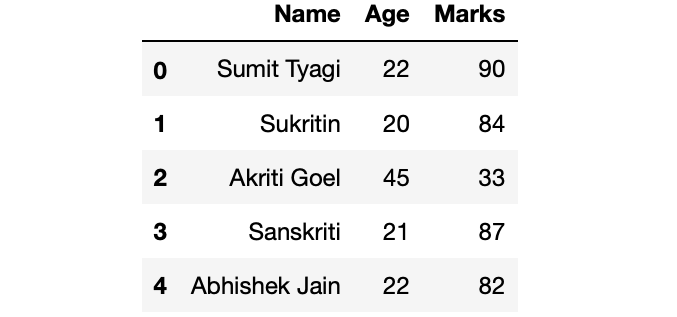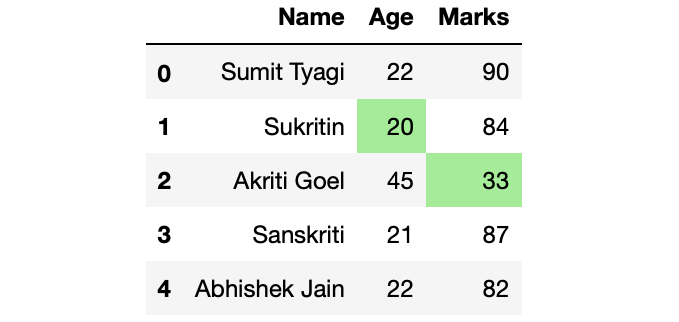Highlight the minimum value in each column In Pandas
Last Updated :
05 Aug, 2020
In this article, we will discuss how to Highlight the minimum values in Pandas Dataframe. So, Let’s first make a dataframe:
Python3
import pandas as pd
import numpy as np
dict = {
'Name': ['Sumit Tyagi', 'Sukritin',
'Akriti Goel', 'Sanskriti',
'Abhishek Jain'],
'Age': [22, 20, 45, 21, 22],
'Marks': [90, 84, 33, 87, 82]
}
df = pd.DataFrame(dict)
print(df)
|
Output:

Now, come to the highlighting part. Our objective is to highlight cells with minimum values in each column.
Method 1: Using df.style.highlight_min() method.
Syntax: DataFrame.style.highlight_min(subset, color, axis)
Parameters:
- subset: Name of the columns of which you want to find the minimum.
- color: Name of the color with which you want to highlight the cell
- axis: {0 or ‘index’, 1 or ‘columns’} based on which axis you want find the minimum.
Returns: Styler object.
Example: Highlighting Cell with minimum value in each column.
Python3
df.style.highlight_min(color = 'lightgreen',
axis = 0)
|
Output:

Method 2: Using the df.style.apply() method.
Syntax: DataFrame.style.apply(self, func, axis=0, subset=None, **kwargs)
Parameters:
- func: It should take a pandas.Series or pandas.DataFrame based on the axis and should return an object with the same shape.
- axis: {0 or ‘index’, 1 or ‘columns’, None}, default 0. Apply to each column (axis=0 or ‘index’), to each row (axis=1 or ‘columns’), or to the entire Dataframe at once with axis=None.
- subset: Set of columns or rows on which you want to call the func.
- **kwargs: Pass along to func.
Returns: Styler object.
Example 1: Highlighting the text instead of cell.
Python3
def highlight_min(s):
is_min = s == s.min()
return ['color: green' if cell else ''
for cell in is_min]
df.style.apply(highlight_min)
|
Output:

Example 2: Highlighting cell with minimum values.
Python3
def highlight_min(s):
is_min = s == s.min()
return ['background: lightgreen' if cell else ''
for cell in is_min]
df.style.apply(highlight_min)
|
Output:

Example 3: Highlighting cell with minimum values but not highlighting the string values.
Python3
def highlight_min(s):
if s.dtype == np.object:
is_min = [False for _ in range(s.shape[0])]
else:
is_min = s == s.min()
return ['background: lightgreen' if cell else ''
for cell in is_min]
df.style.apply(highlight_min)
|
Output:

Like Article
Suggest improvement
Share your thoughts in the comments
Please Login to comment...